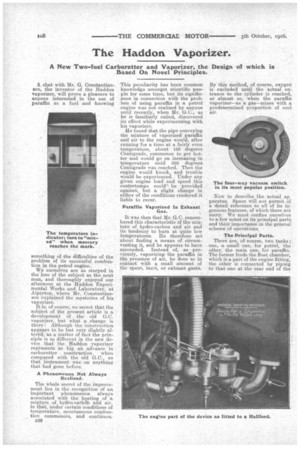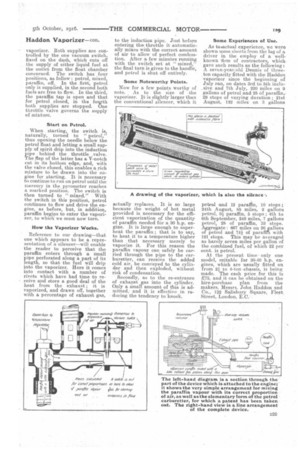The Haddon Vaporizer.
Page 4

Page 5

If you've noticed an error in this article please click here to report it so we can fix it.
A New Two-fuel Carburetter and Vaporizer, the Design of which is Based On Novel Principles.
A chat with Mr. G. Constantine-, scu, the inventor of the Haddon vaporizer, will prove a pleasure to anyone interested in the use of paraffin as a fuel and knowing
something of the difficulties of the problem of its successful combustion in the petrol engine. We ourselves are as steeped in the lore of the subject as the next man, and thoroughly enjoyed ourafternoon at the Haddon Experimental Works and Laboratory, "at Alperton, where Mr. Constantinescu explained the mysteries of his vaporizer.
It is, of course, no secret that the subject of the present article is a development of the old G.C. vaporizer, but what a change is there ! Although the construction appears to be but very slightly altered, as a matter of fact the principle is so different in the new device that the Haddon vaporizer represents as big an advance in carburetter construction, when compared with the old G.C., as that instrument was on anything that had gone before.
A Phenomenon Not Always Realized.
The whole secret of the improvement lies in the recognition of an important phenomenon always associated with the heating of a mixture of hydro-carbki and, air. in that, under certain conditions of temperature, spontaneous combustion commences, and continues.
a2.3
This peculiarity has been common knowledge amongst scientific people for some time, but its significance in connection with the problem of using paraffin in a petrol engine was not realized by anyone until recently, when Mr. G.C., as he is familiarly called, discovered its effect while experimenting with his vaporizer.
He found that the pipe conveying the mixture of vaporized paraffin and air to the engine would, after running for a time at a fairly even temperature, about 150 degrees Centigrade, commence to get hotter and would go on increasing in temperature until 650 degrees Centigrade was reached. Then the engine would knock, and trouble would be experienced. Under any given engine load and speed this contretemps could' be provided against, but a slight change in either of the conditions rendered it liable to recur.
Paraffin Vaporized In Exhaust Gas. • It was then that Mr. G.C. remembered this characteristic of the mixture of hydro-carbon and air and its tendency to burn at quite low, temperatures. He therefore set about finding a means of circumventing it, and he appears to have succeeded. Instead of, as previously, vaporizing the paraffin in the presence of air, he -does so in contact with a small amount of the spent, inert, or exhaust gases.
By this method, of course oxygen is excluded until the actual entrance to the cylinder is reached, or almost so, when the paraffin vaporizer—as a gas—mixes with a predetermined proportion of cool air.
Now to describe the actual ap paratus. Space will not permit of a detail reference to all of its ingenious features, of which there are many. We must confine ourselves to a few note a on its principal parts and their importance in the general scheme of operations. • The Principal Parts.
There are, of course, two tanks ; one, a small one, for petrol, the other, the main one, for paraffin. The former feeds the float chamber, which is a part of the engine fitting, the other is connected by piping to that one at the rear end of the vaporizer. Bath supplies arc controlled by the one vacuum switch, fixed on the dash, which cuts oft the supply of either liquid fuel at the outlet from the float chamber concerned. The switch has four positions, as follow : petrol, mixed, paraffin, off. In the first, petrol only is supplied, in the second both fuels are free to flow. In the third, the paraffin tap is open and that for petrol closed, in the fonith both supplies are stopped. One tftrottle valve governs the supply of mixture.
Start on Petrol.
When starting, the switch is naturally, turned to "petrol,' thus opening the needle below the petrol float and letting a small supply of spirit drip into the induction pipe behind the throttle valve. The flap of the latter has a IT-notch cut in its bottom edge, and, with the valve closed, this enables a rich mixture to be drawn into the engine for starting. It is necessary to continue to run on petrol until the mercury in the pyrometer reaches a marked position. The switch is then turned to "mixed." With the switch in this position, petrol continues to flow and drive the engine, as before, but, in addition, paraffin begins to enter the vaporizer, to which we must now turn.
How the Vaporizer Works.
Reference to our drawing—that one which appears to be a representation of a silencer—will enable the reader to perceive that the paraffin enters through a gmall pipe perforated along a part of its length, so that the fuel will drip into the vaporizer. Here it comes into contact with a number of rivets which have had time to receive and store a good deal of the heat from the exhaust' it is vaporized, and drawn off, together with a percentage of exhaust gas.
to the induction pipe. Just before entering the throttle it automatically mixes with the correct amount of air to allow of perfect combustion. After a few minutes running with the switch set at " mixed," the final turn is given to the handle, and petrol is shut off entirely.
Some Noteworthy Points.
Now for a few points worthy of note. As to the size of the vaporizer. It is slightly larger than the conventional silencer, which it
actually replaces. It is so large because the weight of hot metal provided is necessary for the efficient vaporization of the quantity of paraffin needed fOr a 30 h.p. engine. It is large enough to superheat the paraffin ; that is to say, to heat it to a temperature higher than that necessary merely to vaporize it. For this reason the paraffin vapour can safely be carried through the pipe to the carburetter, can receive the added cold air, be conveyed to the cylinder and then exploded, without risk of condensation.
Secondly, as to the re-entrance of exhaust gas into the cylinder. Only a small amount of this is admitted, and it is effective in reducing the tendency to knock. Some Experiences of Use.
As to4actual experience, we were shown some sheets from the log of a driver in the employ of a wellknown firm of contractors, which gave such results as the following : A seven-year:old Dennis of threeton capacity fitted with the Haddon vaporizer since the beginning of July ran, on dates 3rd to 5th inclusive and 7th July, 220 miles on 9 gallons of petrol and 25 of paraffin, 29 stops of varying duration ; 21st August, 122 miles on 3 gallons petrol and 12 paraffin, 10 stops; 24th August, 85 miles 2 gallons petrol, 95 paraffin, 5 stops; 4th to 6th September, 240 miles, 7 gallons petrol 28 of paraffin, 32 stops. Aggregate : 667 miles on 26 gallons of petrol and 744i of paraffit with 121 stops. This may be averaged as barely seven miles per gallon of the combined fuel, of which 22 per cent. is petrol. At the present time only one model, suitable for 30-40 h.p. engines, which are usually fitted on from 2i. to 4-ten ,chassis, is being made. The cash price for this is £75, and it can be obtained on the hire-purchase plan from the makers, Messrs. John Haddon and Co., 132 Salisbury Square, Fleet Street, London, E.C.
























